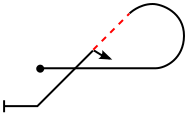| Figure Name | Description | Aresti Symbol |
|---|---|---|
| Chandelle | ||
| Chandelle, Wing-over | Consists of a maximum climb, maximum bank combination to obtain the greatest altitude gain for a given airspeed and at the same time making a 180° course reversal. (Low, positive g maneuver can be performed in all aircraft.) | (Not a competition figure.) |
| Cuban Eight | ||
| Cuban Eight | 5/8's of a loop to the 45 degree line, 1/2 roll, 5/8's of a loop to the 45 degree line, 1/2 roll, 3/8's of a loop to level flight. (Half of the Cuban Eight is called a "half Cuban Eight", and the figure can be flown backwards, known as a "Reverse Cuban Eight") |  |
| Half Cuban Eight | From level flight, 5/8's loop to the inverted 45° line, 1/2 roll to erect down 45° line, pull to level flight. |  |
| Reverse Half Cuban Eight | From level flight pull to the 45° up line, 1/2 roll to inverted 45° up line, then 5/8's of a loop to level flight. |  |
| Hammerhead; Stall Turn | ||
| Hammerhead; Stall Turn | 1/4 loop (pull or push) to vertical, as momentum/airspeed decreases, rudder is applied and the aircraft rotates around its yaw axis, the nose falls through the horizon and points towards the ground, a momentary pause is made to draw the vertical down line, and 1/4 loop to level flight. This figure is sometimes called a stall turn which is a misnomer because the aircraft never actually stalls. The manoeuvre is performed when the aeroplane decelerates through 20 - 30kts (more or less, depending on the aeroplane flown) of airspeed. The cartwheel portion of the hammerhead is performed with full rudder and full opposite aileron. Gyroscopic forces from the propeller during the rapid rate of yaw will produce a pitching and rolling moment and a degree of forward stick will be required to keep the aeroplane from coming off-line over the top. The yaw is stopped with opposite rudder while the ailerons and elevator remain in position, then once the yaw is stopped and the aeroplane is pointed down vertically, all controls are returned to neutral together. Although they can be flown left or right in any aeroplane with the proper technique, a hammerhead is best flown to the left with a clockwise rotating prop, and to the right with an anticlockwise rotating prop (as in a Yakovlev type), due to propeller torque/gyroscopic effects. |  |
| Immelmann; Roll-off-the-top; Split S | ||
| Immelmann; Immelmann turn; Roll-off-the-top; half loop, half roll | 1/2 looping up followed by half a roll. There should be no pause between the end of the looping section and the start of the roll to erect flight. |  |
| Split S | Essentially an Immelmann in reverse. Half roll (from erect to inverted) followed by positive pitch to give a half loop. Converts altitude to airspeed, and reverses direction. |  |
| Up lines | ||
| Vertical up | Fly the aircraft so that the fuselage is perpendicular to the ground (along the wings' Zero lift axis.) The flight path is not judged, and therefore the aircraft may drift downwind during a vertical maneuver. |  |
| 45° up line | The object is for the airplane flight path to be 45°'s from horizontal, as viewed by a ground observer. The actual angle flown when viewed by the pilot would differ depending on whether the figure is flown into or with the wind, and wind strength. |  |
| Loop | ||
| Inside loop | A vertical circle entered from straight and erect level flight. A positive pitching movement is used at all points in the loop to draw the circle. (Aeroplane canopy pointing inwards.) |  |
| Outside loop | A vertical circle entered from straight and erect level flight, canopy pointing out of the loop. Loop can be above or below the straight and level entry altiude, from erect or inverted attitude. (Draws extreme negative gee) |  |
| English bunt | Half an outside loop starting from upright, straight and erect level flight. (The pilot pushes the stick forward and draws a half circle in the sky from the top down.) |  |
| Spin | ||
| Errect spin; Inverted spin; Flat spin | A family of auto-rotational maneuvers, consisting of normal or "flat" spins, eitehr upright or inverted. Two components must exist to spin an aircraft: 1) critical angle of attack (COA), which means that the aircraft is stalled, and 2) yaw. |  |
| Tailslide | ||
| Tailslide | 1/4 looping up, straight vertical (full power) until the aircraft loses momentum. The aircraft falls backwards, tail first, until the nose drops through the horizon to a vertical down position. 1/4 loop (push or pull) to recovers to level flight. |  |
| Snap Roll; Flick roll; Flick | ||
| Snap Roll; Flick roll; Flick | A family of rapid autorotational or "horizontal spins," not unlike spins. Rotation is induced by a rapid pitch input followed by rapid yaw input, thus stalling one wing further than the other. This imbalance in lift causes the high speed roll. | |
- An article should not be list-weighty.
When possible, convert lists to prose (paragraph form).
- For example, this list should be converted to prose.
- Lists are often disruptive to the flow of the text.
- Having lots of lists is looked down on in WP:FAC.
- However, "See also", "References", and "External links" should be lists.
